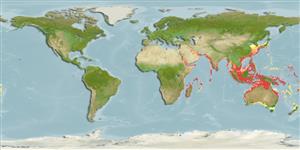Environment: milieu / climate zone / depth range / distribution range
Ecología
marino asociado a arrecife; rango de profundidad 2 - 128 m (Ref. 58479), usually 15 - 30 m (Ref. 90102). Tropical; 42°N - 38°S, 29°E - 174°W
Indo-West Pacific: Red Sea and Persian Gulf south to Mozambique and east to the western Pacific where it ranges from Japan to Sydney (Ref. 11411). Recorded from the Eastern Mediterranean (Ref. 93672).
Tamaño / Peso / Age
Maturity: Lm ? range ? - ? cm
Max length : 12.6 cm TL macho / no sexado; (Ref. 111101); common length : 7.0 cm SL macho / no sexado; (Ref. 37816)
Espinas dorsales (total): 8; Radios blandos dorsales (total): 9; Espinas anales 2; Radios blandos anales: 8. Characterized by having generally white to dusky pinkish body color; 3-4 dark stripes on upper half of body; presence of broad, uniform midlateral stripe continued to caudal fin; narrower stripe above eye to upper caudal peduncle; base of dorsal fin to upper caudal peduncle with thin stripe; incomplete diffuse stripe above midlateral strip; greatest depth of body 2.6-2.7 in SL (Ref. 90102).
Inhabits coastal reefs, in sandy or weedy areas (Ref. 9710). Nocturnal. Juveniles often occur with sea anemones (Ref. 37816).
Life cycle and mating behavior
Madurez | Reproducción | Puesta | Huevos | Fecundidad | Larva
Mouthbrooders (Ref. 240). Distinct pairing during courtship and spawning (Ref. 205).
Paxton, J.R., D.F. Hoese, G.R. Allen and J.E. Hanley, 1989. Pisces. Petromyzontidae to Carangidae. Zoological Catalogue of Australia, Vol. 7. Australian Government Publishing Service, Canberra, 665 p. (Ref. 7300)
IUCN Red List Status (Ref. 130435)
Threat to humans
Harmless
Human uses
Pesquerías: sin interés
Más información
ReferenciasAcuiculturaPerfil de acuiculturaRazasGenéticaElectrophoresesheritabilidadEnfermedadesProcesamientoNutrientsMass conversion
Herramientas
Special reports
Download XML
Fuentes de Internet
Estimates based on models
Preferred temperature (Ref.
123201): 24.6 - 29, mean 28.1 °C (based on 826 cells).
Phylogenetic diversity index (Ref.
82804): PD
50 = 0.5000 [Uniqueness, from 0.5 = low to 2.0 = high].
Bayesian length-weight: a=0.01230 (0.00663 - 0.02283), b=3.09 (2.93 - 3.25), in cm total length, based on LWR estimates for this species & Genus-body shape (Ref.
93245).
Nivel trófico (Ref.
69278): 3.6 ±0.5 se; based on diet studies.
Resiliencia (Ref.
120179): Alto, población duplicada en un tiempo mínimo inferior a 15 meses (Preliminary K or Fecundity.).
Fishing Vulnerability (Ref.
59153): Low vulnerability (10 of 100).
Nutrients (Ref.
124155): Calcium = 108 [55, 177] mg/100g; Iron = 0.852 [0.491, 1.468] mg/100g; Protein = 18.6 [17.4, 19.8] %; Omega3 = 0.147 [0.084, 0.253] g/100g; Selenium = 40.6 [21.3, 77.1] μg/100g; VitaminA = 57.3 [16.3, 203.8] μg/100g; Zinc = 1.42 [0.94, 2.06] mg/100g (wet weight);
